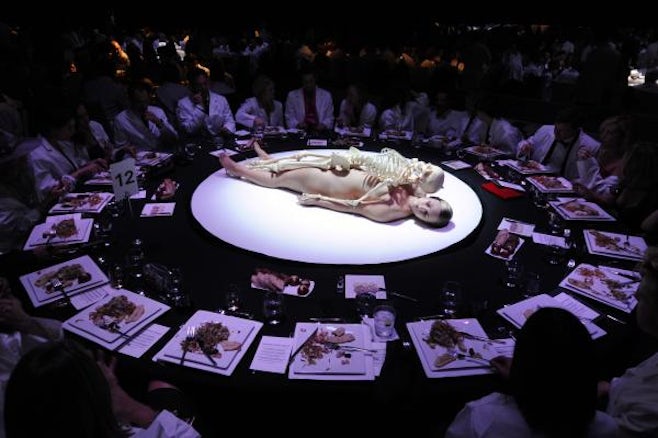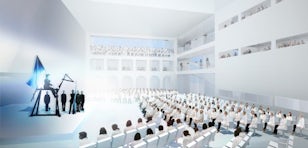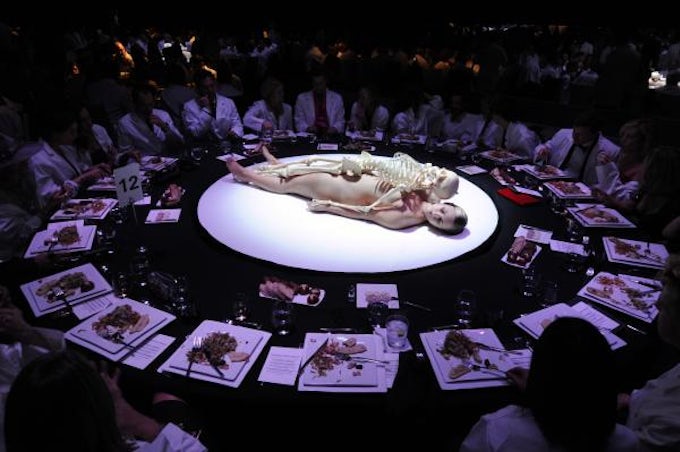
In this ‘age of austerity’, endurance is a virtue. The legally questionable,01undoubtedly precarious employment contracts in Marina Abramović’s 2010 retrospective at The Museum of Modern Art (MoMA), ‘The Artist Is Present’, and the fundraising gala that the artist directed for the Museum of Contemporary Art, Los Angeles (MOCA) in 2011 are dramatised, if standard, expressions of labour relations in the current recession.02 Responses to performance as well as re-performance have generally kept economic and aesthetic critique separated. In her widely circulated letter to MOCA Director Jeffrey Deitch in November 2011, artist Yvonne Rainer, alongside art historian Douglas Crimp and choreographer Taisha Paggett, criticised Abramović’s planned use of performers at the gala on the grounds that the sadism and sexual abuse conjured lacked any ‘socially credible justification’. Instead, Rainer argued that her proposal for the gala showed Abramović’s ‘obliviousness to differences in context (and to) the implications of transposing her own powerful performances to the bodies of others’, even more so when performers were being subjected to ‘public humiliation at the hands of a bunch of frolicking donors’.03Addressing the financial arrangement implicit in the work, the letter concludes that ‘the event is economic exploitation as well, verging on criminality’.04 These words are an invitation to discuss the meaning of endurance as it relates to both performance art and hard labour. As far as the work of (in) art is concerned, what are the conceptual implications of endurance performance by paid labourers?
To briefly sum up the terms of the discussion, performers at MOCA were paid $150 and offered an annual membership to the museum for their shift at the event, including rehearsals.05Most of the tables were decorated with live centrepieces: a slowly rotating performer’s head, the invisible body sitting on a lazy Susan underneath. Others were presided by a performer lying naked under a skeleton, a rendition of Abramović’s Nude with Skeleton (2002/2005/2010).06The remuneration of performers at MoMA’s ‘The Artist Is Present’ was initially $50 for a two and half hour shift, without paid rehearsal time, paid breaks or workers’ compensation.07 Abramović’s newly announced performance art ‘boot camp’, set up to train participants to perform her works, indicates the level of intensity required in the performances and the commitment expected from the workers, regardless of payment.08 The military allusion is not arbitrary; it exemplifies the physically and mentally demanding training involved.09Like soldiers, performers are asked to believe in the work they are doing: monetary incentive is understood to be secondary to the value of cultural enrichment, assistance to an artistic cause and the proximity to celebrity involved. A critical look at re-performance of Abramović’s works as employment, however, reveals short-term and undocumented contracts, without benefits and paid on a potentially less than minimum wage pay scale, even if the labour is physically demanding.

The site of the boot camp, a former theatre and tennis club in Hudson, New York, will be renovated by Rem Koolhaas and his team at OMA into the Marina Abramović Institute for the Preservation of Performance Art, a museum devoted to durational performance.10 The architectural plans were released in May 2012. This development is worth noting for its vision of an enduring spectatorship; where museum viewers will be asked ‘to sign a contract to stay a minimum of six hours. There is no penalty for leaving early, but endurance is rewarded.’11The politics of a museum dedicated to endurance, wherein visitors are considered as participants who are also meant to sleep and eat in the museum itself, in addition to Abramović’s plans to develop a boutique hotel in the city, sparks a debate around the role of the project in fostering a gentrifying ‘creative class’ through a notion of bodily devotion.12 ‘The concept is very clear’, Abramović states, ‘I’m asking you to give me your time, and if you give me your time, I give you experience.’13Announcing 24-hour opening times and individual attendants accompanying visitors on especially designed chairs,14 Abramović’s plans make one fear that, if they are to follow the path of the employment contracts used in her previous projects, experience will not only be the visitors’ reward, but also the remuneration to be expected from its workers.
Payment in the form of access to cultural capital presupposes a location within a class literate in cultural hierarchy. Moreover, performance labourers reflect the state of cultural workers and, by extension, of the middle class, consumers within an experience economy and salaried in immaterial currency. The experiential payment offered across the arts sector, such as unpaid internships, exemplifies Jeremy Rifkin’s analysis of late capitalism and the experience economy, where materialism is replaced by ‘paid for experiences’ and the economy runs on ‘contractual relations’ rather than industrial production.15Even ‘ownership can become an albatross’, Rifkin predicts.16 Rather, Abramović’s labourers illustrate that the increasing gap between those who own both material and immaterial goods and those who own neither is fuelled in part by labour that is compensated with ‘experiential’ non-monetary payment. The erosion of middle class labour conditions apparent in re-performance is only a mild indicator of the far more dire employment circumstances of traditionally ‘non-standard’ workers; namely women, migrants and the most economically disadvantaged.17 But even if prolonged poverty might not be at stake in the precarious employment contracts of re-performers, what they share with those forms of employment classified as ‘vulnerable’ is the perpetuation of ‘an injustice […] resulting from an imbalance of power in the employer-work relationship’.18

If performance art is shaped by material conditions, what effect does this labour relationship have in its current manifestations? I would argue that Abramović’s re-performances became a new work about the enduring body in North America shortly after the 2008 financial meltdown. In contemporary discourse on art and immaterial labour, many thinkers position artists as workers and their bodies as commodities, operating through the Foucaldian trilogy of ‘bureaucratic, administrative and cultural’ modes of immaterial art production.19 Rather than defining post-Fordist immaterial production as ‘free from hard work and exploitation’, as it may at times appear, Boris Groys argues that it presents new bodily demands. He discusses the production of the ‘working body’ in ‘The Artist Is Present’ as the ‘perfect illustration of modernised, alienated work […] in which seemingly nothing material is produced beyond bodies themselves’.20 In contemporary art, the ‘modernised, working body’ becomes the readymade, he argues.
Under this analysis, Groys doesn’t distinguish between the work of hired performers and Abramović’s, viewing their bodies, like readymades, as interchangeable. Two lines of questioning are pertinent to this conclusion. Abramović’s work is popularly understood, and has defined the work of performance, as that of the artist’s individual physical sacrifice. How then, to value the endurance of substitutes? How does one assess the image of crucifixion in Luminosity (1997/2010), in which the performer is suspended nude on a gallery wall facing a bright light, and its attending masochism of ‘heightened being’ if the performer is being paid hourly?21Through the structure of payment alone, a new temporal element is introduced into the performance.
Abramović’s fierce dedication to finishing even the most physically agonising works is recast as financial survival in re-performance. The endurance called upon to complete Luminosity could be understood in this instance to be in the service of making a living, of getting the extra hour, the state of the ‘working body’ in the current economic climate. The reported instances of re-performers fainting, while understood in the context of Abramović’s work as the sheer physical stamina required of the performer, provided the impetus to renegotiate the length of shift times in MoMA’s contract.22 Performance art resonates with the historical conditions of its staging, this is part of its power. Many of Abramović’s works with her former partner Ulay, for example, Point of Contact(1980), were interpreted as expressions of feminist perseverance and militancy. The infamous instance of Abramović fainting while performing Rhythm 5 (1974) is an inextricable component of its legacy. The fainting of the re-performers then, makes up the reconstitution of the work in 2010; a year of fragile economic recovery, the continued erosion of employment conditions in the US and an unemployment rate of 10%. Beyond an argument about whether re-performances mar the original or if true performance can be replicated, it seems worth noting that such events appear under a set of specific contemporary conditions.
Abramović’s re-performances became a new work about the enduring body in North America shortly after the 2008 financial meltdown.
Of course, Abramović is also paid for her work. This brings about the second consideration of Groys’s conclusion. By equating the ‘readymades’ or the body of the artist to those of the workers, Groys overlooks the construction of value implicit within them. Abramović, as a readymade, is worth substantially more than the other bodies at work in ‘The Artist Is Present’. The authenticity that determines her value is subsumed by a comparison to the readymade. Her body is not an assembly-line product, but rather carries the preciousness of an original. Groys does reintroduce a concept of bodily exploitation into immaterial labour and production, but a further materialist reading can be inferred. The actual salaries at stake and their expression of financial imbalance locate these re-performances within the current economic landscape; one presided by an increasingly uneven distribution of wealth.23 Furthermore, Groys’s use of the term ‘readymade’ is particularly poignant considering the disproportionate impact of unemployment on assembly-line workers, the traditional handlers of the readymade.
What kind of suffering does endurance evoke then? Several of MoMA’s re-performers ‘humbly’ called for better employment conditions, noting ‘the many millions in this country out of work and facing economic hardship’.24 The physical form endurance takes in the current labour market manifests in an ‘intensification of work – for example, cleaning more hotel rooms per hour, extending shifts or cutting breaks’,25 paralleling the physical stamina idealised in Abramović’s re-performances. By conjuring the bodies of the disenfranchised masses at a time of continuing economic hardship, re-performance could establish new terrain for performance art, that is, if the range of its implications are incorporated into its critical reception.
Footnotes
-
There have been a number of class action lawsuits against employers on behalf of former unpaid interns, claiming that their internship programmes violate federal minimum wage laws. See Jonathan Allen, ‘Unpaid Intern Sues Harper’s Bazaar for Minimum Wage’, Reuters.com, 2 February 2012). While the performers in both of Abramović’s projects were paid, their contracts arguably violate labour laws, as claim Yvonne Rainer, Douglas Crimp and Taisha Paggett in their letter to MOCA Director Jeffrey Deitch.
-
Marina Abramović’s retrospective ‘The Artist Is Present’ took place at MoMA from 14 March to 13 May 2010 and included, according to their press release, ‘the first live re-performances of Abramović’s works by other people ever to be undertaken in a museum setting’. Abramović was the artistic director of MOCA’s gala, which took place on 12 November 2011 and where performers acted as living table centrepieces, kneeling beneath tables and poking their head through holes in them.
-
Yvonne Rainer, Douglas Crimp and Taisha Paggett, quoted in ‘Yvonne Rainer Accuses Marina Abramovic and LA MoCA of Exploiting Performers’, www.artforum.com, 11 November 2011 (last accessed on 22 May 2012).
-
See Jori Finkle, ‘MOCA Gala’s Main Dish Is Performance Art’, in Latimes.com [online newspaper], 12 November 2011 (last accessed on 16 February 2012)
-
Felix Burrichter, ‘Naked Ambition: Marina Abramovic’s Museum Gala’, in Tmagazine.com [blog], 15 November 2012 (last accessed on 22 May 2012)
-
Abigail Levine, Gary Lai and Rebecca Brooks, ‘Three Reperformers from “Marina Abramovic: The Artist Is Present” Respond to the MOCA Gala Performances’, The Performance Club [blog], 28 November 2011 (last accessed on 16 February 2012). This article reports that after two instances of fainting by re-performers, a pay increase and contract negotiation was achieved, where the re-performers were granted status of ‘temporary employee’ with workman’s compensation and some benefits. They point out that they were still not paid a living wage however and had to work other jobs during the course of the exhibition.
-
Abramović’s boot camp was mentioned in several publications, including this Art Fag City article, which also indicates the cultural privilege understood to be part of the unpaid boot camp experience. Marina Galperina. ‘Marina Abramović Afterthoughts: Willpower, Control, Copyright’, in Art Fag City — New York Art News and Review[online blog], 5 June 2010 (last accessed on 16 February 2012)
-
Martha Rosler calls attention to the military origin of the term avant-garde, first applied to the insurgent notion of autonomous art in the 17th century. Argubly, a recourse to military terminology here offers a similar notion of militant dedication to the work that the use of avant-garde originally did, however it is telling that ‘boot camp’ does not suggest insurgency but extreme obediance. Martha Rosler, ‘Take the Money and Run? Can Political and Socio-Critical Art “Survive”?’ e-flux [online journal], no.12, January 2010 (last accessed on 22 May 2012)
-
Martha Rosler calls attention to the military origin of the term avant-garde, first applied to the insurgent notion of autonomous art in the 17th century. Argubly, a recourse to military terminology here offers a similar notion of militant dedication to the work that the use of avant-garde originally did, however it is telling that ‘boot camp’ does not suggest insurgency but extreme obediance. Martha Rosler, ‘Take the Money and Run? Can Political and Socio-Critical Art “Survive”?’ e-flux [online journal], no.12, January 2010 (last accessed on 22 May 2012)
-
Melena Ryzik, ‘Special Chairs and Lots of Time: Marina Abramovic Plans her New Center’, in Arts Beat-New York Times [online blog], 6 May 2012 (last accessed on 22 May 2012)
-
Ibid.
-
See Martha Rosler, ‘Culture Class: Art, Creativity, Urbanism, Part II’, e-flux [online journal], no.23, March 2011. In Part II of her series on art and urbanism, Rosler discusses Richard Florida’s notion of the ‘creative class’ as a ‘blueprint for urban planners’. As M. Ryzik states very clearly, ‘the ambition of the institute was to make Hudson – which sits near several other art institutions, like the DIA Beacon and the Storm King Sculpture Center – a destination for an art-loving crowd’. M. Ryzik, op. cit.
-
M. Ryzik, op. cit.
-
Melena Ryzik, op. cit. The chair is designed collectively by Koolhaas, Shigematsu and Abramovic. ‘It would be a hybrid between a wheelchair and a massage chair, to be used for repose and even sleeping.’
-
Jeremy Rifkin, The Age of Access: The New Culture of Hypercapitalism, Where All of Life Is a Paid-for Experience, New York: J.P. Tarcher/Putnam, 2000.
-
Stanley M. Davis and Christopher Meyer, Blur: The Speed of Change in the Connected Economy, Oxford: Capstone Publishing Ltd., 1998, p.182, quoted in Ibid., p.41
-
Ali Rogers with Bridget Anderson and Nick Clark, op. cit.
-
Ibid., p.28
-
Boris Groys, ‘Marx, After Duchamp or the Artist’s Two Bodies’, e-flux [online journal], no.19, October 2010.
-
Boris Groys, ‘Marx, After Duchamp or the Artist’s Two Bodies’, e-flux [online journal], no.19, October 2010.
-
A performer of Luminosity in ‘The Artist Is Present’ likens the experience to meditation: ‘if creativity is enlightenment, then performing Luminosity is, to me, a critical step on the path’; even while the ‘pain is distracting’. Isabelle Lumpkin, ‘On Being Marina Abramović’ in Nyfa.org [online blog], New York Foundation for the Arts, New York (last accessed on 21 May 2012)
-
Abigail Levine, Gary Lai and Rebecca Brooks, op. cit.
-
See David Harvey’s account of this disproportionate concentration of wealth, in particular his notion of ‘accumulation by dispossession’, in A Brief History of Neoliberalism, New York: Oxford University Press, 2005. Claire Bishop discusses social inequality in relation to current neoliberal policies in her article ‘Con-demmed to the Bleakest of Futures: Report from the UK’, e-flux [online journal], no.22, January 2011 (last accessed on 23 May 2012).
-
Abigail Levine, Gary Lai and Rebecca Brooks, op. cit.
-
Ali Rogers with Bridget Anderson and Nick Clark, Recession, Vulnerable Workers and Immigration: Background Report, op. cit.
